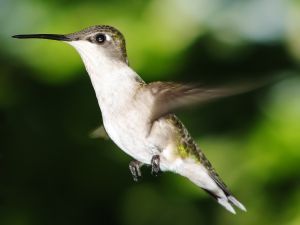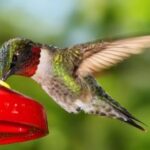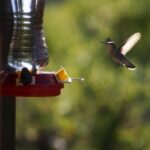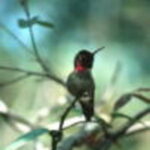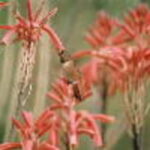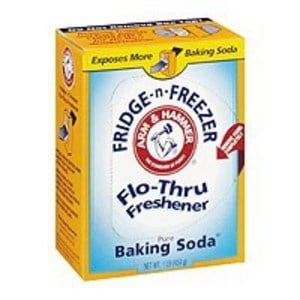The great State of Iowa has the pleasure of being host to at least two species of hummingbirds on their migration route, both North to South and South to North. The two hummingbird species that are commonly documented in Iowa are the Ruby-throated Hummingbird and the Rufous Hummingbird. These tiny birds are guests in Iowa during their spring migration, usually towards the end of April and stay until sometime in May, and then they return during their fall migration and stay during August and September.
Identifying the hummingbirds that are visiting that new feeder you just hung or that are enjoying the nectar provided for from the flowers in that carefully planted hummingbird garden is not very difficult, even though both species are similar in size. They certainly are not similar in color. The male Ruby-throated Hummingbird, who is coincidently the smallest of these hummingbirds at about 3.1 grams, is probably the most common known hummingbird anywhere. This is the hummingbird that has the ruby red throat, which gives this species its name. This male also has an emerald green back and a forked tail. The female of this species is just a little bit larger than the male and has the emerald green back, but that is where the similarities end as the female has a white breast and throat and has a round tail.
The male Rufous Hummingbird is the largest male of these two species, weighing in at about 3.2 grams. This male is much like the Ruby-throated male because the species is named after the coloration of the male, which in this case is the predominate rufous color found on the tail, crown and each side. This little bird also has a white breast and an orange-red throat and a back that is either rufous, green or a combination of rufous and green. The female Rufous Hummingbird is the largest hummingbird of these two species with an average weight of 3.4 grams. This bird has a white breast like the male of the species, but that is where the similarity ends between the two sexes. The female has a green crown and back and its tail feathers are rufous, tipped with white.
Gardeners who are interested in creating a hummingbird garden to attract these beautiful little birds should include trees, shrubs and flowers that are red, pink and tubular. This includes trees and shrubs such as red buckeye, northern catalpa, bottlebrush, coralberry, lilac and red prince weigela. Annual flowers to consider are four o’clock, fuchsia, impatiens, morning glory, nicotiana, petunias, pineapple sage, red salvia, scarlet runner bean, shrimp plant and zinnia. Perennial flowers to consider are bee balm, cannas, columbine, coral bells, delphinium, daylily, hibiscus, hollyhock, hosta, Liatris, lily, lobelia, penstemon, phlox, Russell hybrid lubine, trumpet vine and yucca. With a flower garden and/or a landscape that includes some of these plants, along with some hummingbird feeders, these tiny travelers should become guests at least twice a year and hopefully they will return for many years to come.
